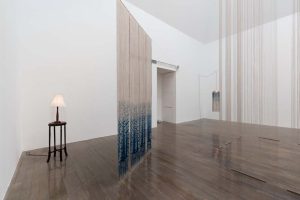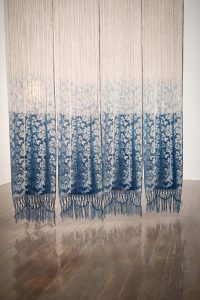A House of Memory Traces (Publicness of the Art Center): Art Tower Mito

A House of Memory Traces, 2019 (Installation View, Publicness of the Art Center, Contemporary Art Center Art Tower Mito, Ibaraki, Japan))
Backstrap weaving, macramé, cyanotype, on Flax, lampshade, light bulb, bobbin, wooden stand, with sound (14’52”)
Dimensions variable
Photo: Yuzuru Nemoto

A House of Memory Traces, 2019 (Installation View, Publicness of the Art Center, Contemporary Art Center Art Tower Mito, Ibaraki, Japan))
Backstrap weaving, macramé, cyanotype, on Flax, lampshade, light bulb, bobbin, wooden stand, with sound (14’52”)
Dimensions variable
Photo: Yuzuru Nemoto

A House of Memory Traces, 2019 (Installation View, Publicness of the Art Center, Contemporary Art Center Art Tower Mito, Ibaraki, Japan))
Backstrap weaving, macramé, cyanotype, on Flax, lampshade, light bulb, bobbin, wooden stand, with sound (14’52”)
Dimensions variable
Photo: Yuzuru Nemoto

A House of Memory Traces, 2019 (Installation View, Publicness of the Art Center, Contemporary Art Center Art Tower Mito, Ibaraki, Japan))
Backstrap weaving, macramé, cyanotype, on Flax, lampshade, light bulb, bobbin, wooden stand, with sound (14’52”)
Dimensions variable
Photo: Yuzuru Nemoto

A House of Memory Traces, 2019 (Installation View, Publicness of the Art Center, Contemporary Art Center Art Tower Mito, Ibaraki, Japan))
Backstrap weaving, macramé, cyanotype, on Flax, lampshade, light bulb, bobbin, wooden stand, with sound (14’52”)
Dimensions variable
Photo: Yuzuru Nemoto

A House of Memory Traces, 2019 (Installation View, Publicness of the Art Center, Contemporary Art Center Art Tower Mito, Ibaraki, Japan))
Backstrap weaving, macramé, cyanotype, on Flax, lampshade, light bulb, bobbin, wooden stand, with sound (14’52”)
Dimensions variable
Photo: Yuzuru Nemoto

A House of Memory Traces, 2019 (Installation View, Publicness of the Art Center, Contemporary Art Center Art Tower Mito, Ibaraki, Japan))
Backstrap weaving, macramé, cyanotype, on Flax, lampshade, light bulb, bobbin, wooden stand, with sound (14’52”)
Dimensions variable
Photo: Yuzuru Nemoto

A House of Memory Traces, 2019 (Installation View, Publicness of the Art Center, Contemporary Art Center Art Tower Mito, Ibaraki, Japan))
Backstrap weaving, macramé, cyanotype, on Flax, lampshade, light bulb, bobbin, wooden stand, with sound (14’52”)
Dimensions variable
Photo: Yuzuru Nemoto

A House of Memory Traces, 2019 (Installation View, Publicness of the Art Center, Contemporary Art Center Art Tower Mito, Ibaraki, Japan))
Backstrap weaving, macramé, cyanotype, on Flax, lampshade, light bulb, bobbin, wooden stand, with sound (14’52”)
Dimensions variable
Photo: Yuzuru Nemoto

A House of Memory Traces, 2019 (Installation View, Publicness of the Art Center, Contemporary Art Center Art Tower Mito, Ibaraki, Japan))
Backstrap weaving, macramé, cyanotype, on Flax, lampshade, light bulb, bobbin, wooden stand, with sound (14’52”)
Dimensions variable
Photo: Yuzuru Nemoto


A House of Memory Traces, 2019 (Installation View, Publicness of the Art Center, Contemporary Art Center Art Tower Mito, Ibaraki, Japan))
Backstrap weaving, macramé, cyanotype, on Flax, lampshade, light bulb, bobbin, wooden stand, with sound (14’52”)
Dimensions variable
Photo: Yuzuru Nemoto
Haji Oh
26 Oct 2019 - 26 Jan 2020
Publicness of the Art Center
Art Tower Mito, Ibaraki, Japan
Marking 30 years in 2020 since Art Tower Mito’s opening, the Contemporary Art Center’s Publicness of the Art Center explores over two phases the role required of an art center in today’s changing society. Phase 1 was organized from March to May 2019, reinterpreting the Contemporary Art Center as a place where art is born and using the facility’s gallery space for creativity and dialogue between both artists and visitors as well as between fellow visitors. In Phase 2, the gallery will be employed as a space for cultivating dialogue and various activities centered on an exhibition.
This exhibition presented new work created by six artists who were invited to take up one-month residencies during Phase 1, conducting research on the Mito area and the Contemporary Art Center, and collaborating with local citizens. It featured documentary footage from Osamu Jareo’s Metamorphosis workshop, ongoing since Phase 1 and exploring the nature of dialogue and physical expression, as well as other workshops and the final presentations of the results.
“A House of Memory Traces is Chapter 3 of the Grand-mother Island project. It consists of textiles and recorded audio voices of 45 women, reading the texts taken from the National Library of Australia collection, “Nikkei kokusai kekkon shinbokukai nyusureta” (Japanese International Marriage Fellowship Club Newsletter, 1989-1994). These newsletters were written by Japanese war brides in Australia and other countries. They might have received the newsletters at home and spent time reading them sitting on the chair in their living room or kitchen. They shared their past experiences and present time of life through the newsletters. These newsletters are now part of the collection at the library. It enables people to access their experiences to feel and share. The installation evokes to imagine the time spent in their private space and their experiences.”
Grand-mother Island project traces the trajectories of people who have crossed the Pacific Ocean, such as between Australia, Japan, and Korea, focusing on how individual narratives are interwoven with history to create new communities.
Grand-mother Island constitutes an imaginary space that inherits and generates untold stories beyond the nation. According to Benedict Anderson, the nation is an imagined political community, where imagining a shared history strengthens a sense of national belonging. This project imagines space between nations, spaces of movement that expand our horizons. Using the metaphor and universal experience of the grandmother, it brings to life stories of connected pasts that open us to others.
